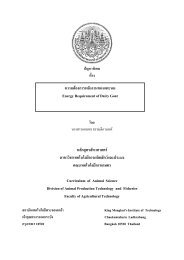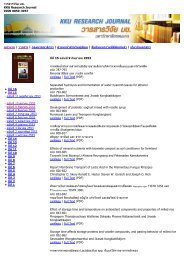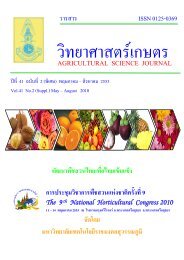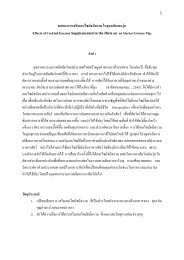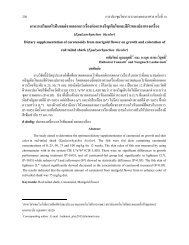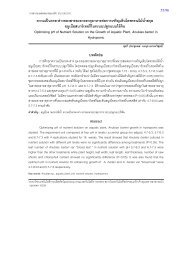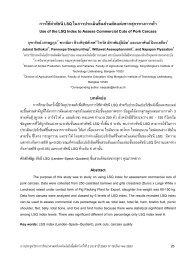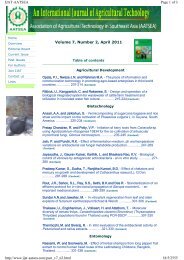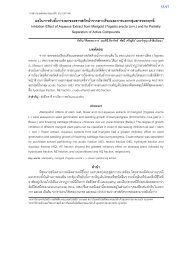Effect of pH on Biosorption of Basic Dye Malachite Green bt Algae
Effect of pH on Biosorption of Basic Dye Malachite Green bt Algae
Effect of pH on Biosorption of Basic Dye Malachite Green bt Algae
Create successful ePaper yourself
Turn your PDF publications into a flip-book with our unique Google optimized e-Paper software.
<str<strong>on</strong>g>Effect</str<strong>on</strong>g> <str<strong>on</strong>g>of</str<strong>on</strong>g> <str<strong>on</strong>g>pH</str<strong>on</strong>g> <strong>on</strong> Biosorpti<strong>on</strong> <str<strong>on</strong>g>of</str<strong>on</strong>g> <strong>Basic</strong> <strong>Dye</strong> <strong>Malachite</strong> <strong>Green</strong><br />
<strong>bt</strong> <strong>Algae</strong><br />
Kawin Pansamrit and Suneerat Ruangsombo<strong>on</strong> *<br />
1 Program in Fisheries Science, Divisi<strong>on</strong> <str<strong>on</strong>g>of</str<strong>on</strong>g> Animal Producti<strong>on</strong> Technology and Fisheries,<br />
Faculty <str<strong>on</strong>g>of</str<strong>on</strong>g> Agricultural Technology, King M<strong>on</strong>gkut’s Institute <str<strong>on</strong>g>of</str<strong>on</strong>g> Technology<br />
Ladkrabang, Bangkok, Thailand<br />
Abstract<br />
The optimal <str<strong>on</strong>g>pH</str<strong>on</strong>g> for malachite green (basic dye OT 70701 A) removal from soluti<strong>on</strong> by 13 genus<br />
<str<strong>on</strong>g>of</str<strong>on</strong>g> algae (Acanthophora sp., Gracilaria sp., Solieria sp., Padina sp., Turbinaria sp., Dictyota sp.,<br />
Sargassum sp., Caulerpa lentillifera, Caulerpa sertularioides., Cladophora sp., Ulva rigida, Ulva<br />
intestinalis, Chaetomorpha sp., Spirulina platensis and Phormidium angustissimum) was studied.<br />
Dried algal cells were added in malachite green soluti<strong>on</strong> with initial c<strong>on</strong>centrati<strong>on</strong> <str<strong>on</strong>g>of</str<strong>on</strong>g> 5 mg/L at<br />
initial <str<strong>on</strong>g>pH</str<strong>on</strong>g> 2, 3, 4, 5, 6, 7 and 8 and shaking for 3 h. The optimum <str<strong>on</strong>g>pH</str<strong>on</strong>g> for malachite green sorpti<strong>on</strong><br />
by Solieria sp. was 5, S. platensis., U. intestinalis and U. rigida was 7 and other genus <str<strong>on</strong>g>of</str<strong>on</strong>g> algae<br />
was 6. Padina sp. showed significantly higher biosorpti<strong>on</strong> ability, 4.28±0.03 mg/g dry wt., than<br />
other algae (p
eported that <str<strong>on</strong>g>pH</str<strong>on</strong>g> not <strong>on</strong>ly affects the dye biosorpti<strong>on</strong> capacity but also the solubility <str<strong>on</strong>g>of</str<strong>on</strong>g> dyes [7]<br />
and surface binding-sites <str<strong>on</strong>g>of</str<strong>on</strong>g> cell wall <str<strong>on</strong>g>of</str<strong>on</strong>g> algae c<strong>on</strong>tains several charged group [8]. Therefore <str<strong>on</strong>g>pH</str<strong>on</strong>g> is<br />
an important factor in dye removal.<br />
The aim <str<strong>on</strong>g>of</str<strong>on</strong>g> the present study was to evaluate the effect <str<strong>on</strong>g>of</str<strong>on</strong>g> <str<strong>on</strong>g>pH</str<strong>on</strong>g> <strong>on</strong> malachite green removal<br />
from aqueous soluti<strong>on</strong> by algae and to evaluate the ability and potential use <str<strong>on</strong>g>of</str<strong>on</strong>g> algae to remove<br />
malachite green.<br />
2. Materials and Methods<br />
2.1 Macroalgae and Microalgae (cyanobacteria)<br />
Marine macroalgae were collected from natural and aquatic farm. Caulerpa lentillifera, Caulerpa<br />
sertularioides and Acanthophora sp. were collected from Banj<strong>on</strong>g Farm, Chachoengsao province<br />
<strong>on</strong> May. Cladophora sp., Chaetomorpha sp., Ulva rigida and Ulva intestinalis were collected from<br />
Trat coastal aquaculture stati<strong>on</strong>, Trat province <strong>on</strong> May. Sargassum sp., Dictyota sp. and<br />
Turbinaria sp. were collected from Ch<strong>on</strong>buri province <strong>on</strong> March. Padina sp. were collected from<br />
Trat province. Gracilaria sp. and Solieria sp. were collected from Samutsakr<strong>on</strong> province <strong>on</strong> April.<br />
The algae were washed with water to remove the surface-adhered particles and dried with sun<br />
light then powdered to study the malachite green removal ability.<br />
Cyanobacteria (Spirulina platensis and Phormidium angustissimum) were o<strong>bt</strong>ained from<br />
the King M<strong>on</strong>gkut’s Institute <str<strong>on</strong>g>of</str<strong>on</strong>g> Technology Ladkrabang, Faculty <str<strong>on</strong>g>of</str<strong>on</strong>g> Agricultural Technology,<br />
Program in Fisheries Science, Divisi<strong>on</strong> <str<strong>on</strong>g>of</str<strong>on</strong>g> Animal Producti<strong>on</strong> Technology and Fisheries (KMITL,<br />
Bangkok, Thailand). S. platensis was cultured in Zarrouk’s medium and P. angustissimum was<br />
cultured in BG-11 medium under c<strong>on</strong>tinuous illuminati<strong>on</strong> <str<strong>on</strong>g>of</str<strong>on</strong>g> 30 µmol phot<strong>on</strong>s/m 2 /s at 28±2ºC. The<br />
cyanobacterial cells at 2 weeks period <str<strong>on</strong>g>of</str<strong>on</strong>g> culture (late exp<strong>on</strong>ential phase) were harvested by<br />
filtrati<strong>on</strong> and dried at 60 ºC. and powdered before studying the malachite green removal ability.<br />
2.2 <strong>Basic</strong> dye removal ability<br />
To study the basic dye removal ability (qeq): 0.01 g (dry weight) <str<strong>on</strong>g>of</str<strong>on</strong>g> algal cells was added in 10 mL<br />
soluti<strong>on</strong> <str<strong>on</strong>g>of</str<strong>on</strong>g> malachite green at c<strong>on</strong>centrati<strong>on</strong>s <str<strong>on</strong>g>of</str<strong>on</strong>g> 5 mg/L at <str<strong>on</strong>g>pH</str<strong>on</strong>g> 2, 3, 4, 5, 6, 7 and 8 in a 125-mL<br />
Erlenmeyer flask. The flasks were shaken at 120 rpm <strong>on</strong> a shaker at 25 °C for 180 min. Then algal<br />
cells were separated by filtrati<strong>on</strong>. <strong>Malachite</strong> green remained in soluti<strong>on</strong> was analyzed. The values<br />
<str<strong>on</strong>g>of</str<strong>on</strong>g> qeq were calculated using the mass balance equati<strong>on</strong>: qeq = V(Ci-Ceq)/M where Ci is the initial<br />
dye c<strong>on</strong>centrati<strong>on</strong> (mg/L), Ceq is the final c<strong>on</strong>centrati<strong>on</strong> <str<strong>on</strong>g>of</str<strong>on</strong>g> dye soluti<strong>on</strong> (mg/L), V is the volume <str<strong>on</strong>g>of</str<strong>on</strong>g><br />
soluti<strong>on</strong> (mL), and M is algal dry weight (g).<br />
2.3 <strong>Basic</strong> dye and Statistical analysis<br />
<strong>Basic</strong> dye (malachite green) c<strong>on</strong>centrati<strong>on</strong> was analyzed by a spectrophotometer (Becthai,<br />
Thailand) at wavelength 618 nm. All experiments were c<strong>on</strong>ducted in three replicates. Significant<br />
differences were determined using analysis <str<strong>on</strong>g>of</str<strong>on</strong>g> variance (ANOVA) with 95% c<strong>on</strong>fidence<br />
(probability limit <str<strong>on</strong>g>of</str<strong>on</strong>g> p
Solieria sp. (0.50±0.03 mg/g dry wt.) and Chaetomorpha sp. (0.61±0.02 mg/g dry wt.) showed<br />
significantly lower dye removal ability than other algae (p0.05)<br />
The same capital letter in each column mean absence <str<strong>on</strong>g>of</str<strong>on</strong>g> statistical differences (p>0.05)<br />
2.29±0.03 eF<br />
3.75±0.04 hE<br />
0.49±0.02 aD<br />
4.28±0.03 kF<br />
4.05±0.03 jE<br />
3.81±0.01 hiF<br />
4.10±0.02 jE<br />
3.17±0.03 gD<br />
2.32±0.02 eE<br />
3.90±0.04 iE<br />
0.72±0.07 bcD<br />
0.78±0.01 cE<br />
0.61±0.02 abD<br />
2.00±0.14 dC<br />
2.55±0.04 fF<br />
2.10±0.01 cE<br />
3.32±0.01 fD<br />
0.47±0.01 aCD<br />
3.43±0.02 fghD<br />
3.41±0.02 fgD<br />
3.48±0.02 ghiE<br />
3.60±0.01 iD<br />
2.68±0.01 eC<br />
2.23±0.00 cD<br />
3.58±0.00 hiD<br />
0.72±0.02 bC<br />
0.82±0.01 bC<br />
0.52±0.01 aC<br />
2.44±0.10 dD<br />
2.21±0.01 cE<br />
2.08±0.02 cE<br />
3.25±0.01 gD<br />
0.45±0.01 aCD<br />
3.57±0.02 hiE<br />
3.49±0.02 hiD<br />
3.48±0.01 hE<br />
3.63±0.01 iD<br />
2.76±0.02 fC<br />
2.18±0.03 cdCD<br />
3.53±0.05 hiD<br />
0.71±0.01 bC<br />
0.75±0.03 bC<br />
0.54±0.02 aC<br />
2.41±0.16 eD<br />
2.23±0.02 dE<br />
At a higher <str<strong>on</strong>g>pH</str<strong>on</strong>g> above this zero point charge, the surface <str<strong>on</strong>g>of</str<strong>on</strong>g> biomass gets negatively<br />
charged, which enhances the positively charged <str<strong>on</strong>g>of</str<strong>on</strong>g> dye cati<strong>on</strong>s through electrostatic force <str<strong>on</strong>g>of</str<strong>on</strong>g><br />
attracti<strong>on</strong> and at lower <str<strong>on</strong>g>pH</str<strong>on</strong>g>, the surface charge may get positively charged (i.e. prot<strong>on</strong>ati<strong>on</strong> <str<strong>on</strong>g>of</str<strong>on</strong>g> the<br />
cell wall), thus making (H+) i<strong>on</strong>s compete effectively with dye cati<strong>on</strong>s toward actives sorpti<strong>on</strong><br />
sites causing a decrease in the amount <str<strong>on</strong>g>of</str<strong>on</strong>g> adsorbed dye [1, 4, 8]. Many studies have been d<strong>on</strong>e <strong>on</strong><br />
effect <str<strong>on</strong>g>of</str<strong>on</strong>g> initial <str<strong>on</strong>g>pH</str<strong>on</strong>g> soluti<strong>on</strong> <strong>on</strong> the color removal effciency <str<strong>on</strong>g>of</str<strong>on</strong>g> malachite green soluti<strong>on</strong> by green<br />
algae. Cosmarium sp. <strong>Malachite</strong> green removed ability was analyzed over a <str<strong>on</strong>g>pH</str<strong>on</strong>g> range from 2.0 to<br />
11.0. It shown that an increase in <str<strong>on</strong>g>pH</str<strong>on</strong>g> from 4.0 to 6.0 leads to a threefold increase in decolorizati<strong>on</strong>
ate, which is reached the maximum value <str<strong>on</strong>g>of</str<strong>on</strong>g> 92.4% at the <str<strong>on</strong>g>pH</str<strong>on</strong>g> <str<strong>on</strong>g>of</str<strong>on</strong>g> 9.0 and the color removal<br />
effciency from 26.3% to 68.4% for an increase in <str<strong>on</strong>g>pH</str<strong>on</strong>g> from 3.0 to 4.0 [4].<br />
d<br />
g<br />
a<br />
i<br />
h<br />
g<br />
Figure 1. <strong>Basic</strong> dye removal ability (qeq, mg/g dry wt.) <str<strong>on</strong>g>of</str<strong>on</strong>g> algae with optimal <str<strong>on</strong>g>pH</str<strong>on</strong>g> (initial dye<br />
c<strong>on</strong>centrati<strong>on</strong> <str<strong>on</strong>g>of</str<strong>on</strong>g> 5 mg/l). The same small letter mean absence <str<strong>on</strong>g>of</str<strong>on</strong>g> statistical differences (p>0.05)<br />
The influence <str<strong>on</strong>g>of</str<strong>on</strong>g> initial dye soluti<strong>on</strong> <str<strong>on</strong>g>pH</str<strong>on</strong>g> <str<strong>on</strong>g>of</str<strong>on</strong>g> malachite green removal by a fresh water<br />
algae Pithophora sp. at different soluti<strong>on</strong> <str<strong>on</strong>g>pH</str<strong>on</strong>g> ranging from 2 to 7 at initial malachite green<br />
c<strong>on</strong>centrati<strong>on</strong> 50 mg/L was studied. It was shown that maximum <str<strong>on</strong>g>of</str<strong>on</strong>g> 64.4 mg/g <str<strong>on</strong>g>of</str<strong>on</strong>g> dye was<br />
adsorbed at a <str<strong>on</strong>g>pH</str<strong>on</strong>g> <str<strong>on</strong>g>of</str<strong>on</strong>g> 6 [1]. The optimum initial <str<strong>on</strong>g>pH</str<strong>on</strong>g> for malachite green removal by brown algae<br />
Turbinaria c<strong>on</strong>oides biomass at initial dye c<strong>on</strong>centrati<strong>on</strong> 100 mg/L was found to be 8.0 and<br />
showed maximum adsorpti<strong>on</strong> capacity 66.6 mg/g [9].<br />
The effect <str<strong>on</strong>g>of</str<strong>on</strong>g> <str<strong>on</strong>g>pH</str<strong>on</strong>g> <strong>on</strong> removal <str<strong>on</strong>g>of</str<strong>on</strong>g> basic dye, methylene blue using green alga Enteromorpha<br />
spp. was investigated for values between 2 and 10. The sorpti<strong>on</strong> capacity was minimum at <str<strong>on</strong>g>pH</str<strong>on</strong>g> 2<br />
(40.21 mg/g) and increased up to <str<strong>on</strong>g>pH</str<strong>on</strong>g> 6, then remained nearly c<strong>on</strong>stant (70.35 mg/g) over the initial<br />
<str<strong>on</strong>g>pH</str<strong>on</strong>g> ranges <str<strong>on</strong>g>of</str<strong>on</strong>g> 6–10 [10]. The percentage sorpti<strong>on</strong> <str<strong>on</strong>g>of</str<strong>on</strong>g> methylene blue by giant duckweed Spirodela<br />
polyrrhiza at initial <str<strong>on</strong>g>pH</str<strong>on</strong>g> between 2-11 was reported. S. polyrrhiza showed minimum sorpti<strong>on</strong> at the<br />
initial <str<strong>on</strong>g>pH</str<strong>on</strong>g> 2, and the percentage sorpti<strong>on</strong> <str<strong>on</strong>g>of</str<strong>on</strong>g> methylene blue was not significantly altered (p>0.05)<br />
when the initial <str<strong>on</strong>g>pH</str<strong>on</strong>g> was increased from 3 to 11. S. polyrrhiza showed maximum adsorpti<strong>on</strong><br />
capacity between 126.58-129.87 mg/g [11].<br />
4. C<strong>on</strong>clusi<strong>on</strong>s<br />
The optimal <str<strong>on</strong>g>pH</str<strong>on</strong>g> for malachite green (basic dye OT 70701 A) removal by Soliera sp. was 5,<br />
Spirulina platensis, Ulva intestinalis and Ulva. rigida was 7 and Acanthophora sp., Gracilaria sp.,<br />
Padina sp., Turbinaria sp., Dictyota sp., Sargassum sp., Caulerpa lentilifera, Caulerpa<br />
The 8 th Internati<strong>on</strong>al Symposium <strong>on</strong> Bioc<strong>on</strong>trol and Biotechnology 223<br />
h<br />
d<br />
f<br />
g<br />
bc c<br />
ab<br />
de e
sertularioides, Cladophora sp., Chaetomorpha sp. and Phormidium angustissimum was 6. Padina<br />
sp. showed the highest malachite green removal ability.<br />
5. Acknowledgements<br />
This study was grants by the Nati<strong>on</strong>al Research Council <str<strong>on</strong>g>of</str<strong>on</strong>g> Thailand.<br />
References<br />
[1] Kumar, K.V., Ramamurthi, V. and Sivanesan S., 2006. Biosorpti<strong>on</strong> <str<strong>on</strong>g>of</str<strong>on</strong>g> malachite green, a<br />
cati<strong>on</strong>ic dye <strong>on</strong>to Pithophora sp., a fresh water algae. <strong>Dye</strong>s and Pigments, 69, 102-107.<br />
[2] Sivaraj, R., Namasivayam, C. and Kadirvelu, K., 2001. Orange peel as an adsorbent in the<br />
removal <str<strong>on</strong>g>of</str<strong>on</strong>g> acid violet 17 (acid ye) from aqueous soluti<strong>on</strong>s, Waste Management, 21, 105-10.<br />
[3] Bekci, Z., Seki, Y. and Cavasb, L., 2009. Removal <str<strong>on</strong>g>of</str<strong>on</strong>g> malachite green by using an invasive<br />
marine alga Caulerpa racemosa var. cylindracea. Journal <str<strong>on</strong>g>of</str<strong>on</strong>g> Hazardous Materials, 161,<br />
1454–1460.<br />
[4] Daneshvar, N., Ayazloo M., Khataee, A.R. and Pourhassan, M., 2007. Biological<br />
decolorizati<strong>on</strong> <str<strong>on</strong>g>of</str<strong>on</strong>g> dye soluti<strong>on</strong> c<strong>on</strong>taining <strong>Malachite</strong> <strong>Green</strong> by microalgae Cosmarium sp.<br />
Bioresource Technology, 98, 1176–1182.<br />
[5] Marungrueng, K. and Pavasant, P., 2007. High performance biosorpbent (Caulerpa<br />
lentillifera) for basic dye removal. Bioresource Technology, 98, 1567-1572.<br />
[6] Wafaa, M., El-Rahim, A. and El-Ardy, O.A.M., 2008. Hassan Moawad, Aerati<strong>on</strong> as a factor<br />
in textile dye bioremoval by Aspergillus niger. African Journal <str<strong>on</strong>g>of</str<strong>on</strong>g> Biochemistry Research,<br />
2(1), 30–39.<br />
[7] Fu, Y.Z. and Viraraghavan, T., 2001. Removal <str<strong>on</strong>g>of</str<strong>on</strong>g> CI Acid Blue 29 from an aqueous<br />
soluti<strong>on</strong> by Aspergillus niger. American Associati<strong>on</strong> <str<strong>on</strong>g>of</str<strong>on</strong>g> Textile Chemists and Colorists<br />
Review, 1(1), 36–40.<br />
[8] Tsai W.T. and Chen H.R., 2010. Removal <str<strong>on</strong>g>of</str<strong>on</strong>g> malachite green from aqueous soluti<strong>on</strong> using<br />
low-cost chlorella-based biomass. Journal <str<strong>on</strong>g>of</str<strong>on</strong>g> Hazardous Materials, 175, 844–849.<br />
[9] Kannan, R.R., Rajasimman, M., Rajamohan, N. and Siaprakash, B., 2010. Brown marine<br />
algae Turbinaria c<strong>on</strong>oides as biosorbent for <strong>Malachite</strong> green removal: Equilibrium and<br />
kinetic modeling. Fr<strong>on</strong>tiers <str<strong>on</strong>g>of</str<strong>on</strong>g> Envir<strong>on</strong>mental Science and Engineering in China, 4(1), 116–<br />
122.<br />
[10] Ncibi, M.C., Hamissa, A.M.B., Fathallah, A., Kortas, M.H., Baklouti, T., Mahjoub, B. and<br />
Seffen, M., 2009. Biosorptive uptake <str<strong>on</strong>g>of</str<strong>on</strong>g> methylene blue using Mediterranean green alga<br />
Enteromorpha spp. Journal <str<strong>on</strong>g>of</str<strong>on</strong>g> Hazardous Materials, 170, 1050–1055.<br />
[11] Waranusantigul, P., Pokethitiyooka, P., Kruatrachuea, M. and Upathama, E.S., 2003.<br />
Kinetics <str<strong>on</strong>g>of</str<strong>on</strong>g> basic dye (methylene blue) biosorpti<strong>on</strong> by giant duckweed (Spirodela<br />
polyrrhiza). Envir<strong>on</strong>mental Polluti<strong>on</strong>, 125, 385–392.<br />
The 8 th Internati<strong>on</strong>al Symposium <strong>on</strong> Bioc<strong>on</strong>trol and Biotechnology 224





